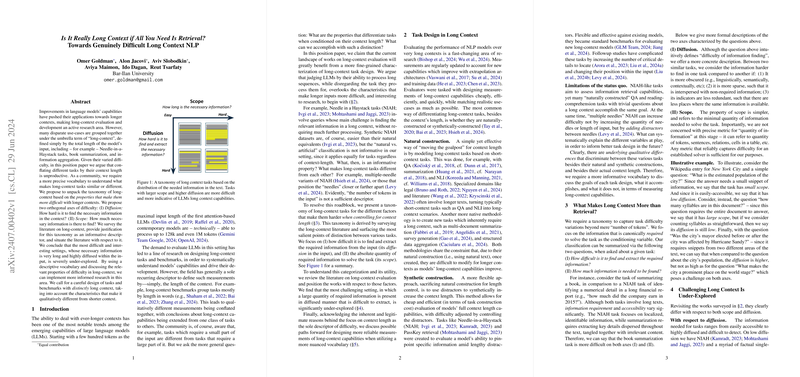Overview of "Is It Really Long Context if All You Need Is Retrieval? Towards Genuinely Difficult Long Context NLP"
The paper by Omer Goldman et al., titled "Is It Really Long Context if All You Need Is Retrieval? Towards Genuinely Difficult Long Context NLP," proposes a nuanced examination of “long-context” tasks in NLP. The authors argue that current categorizations based on context length alone are insufficient and suggest a more granular taxonomy to better articulate the challenges of long-context NLP tasks. This paper critiques the prevalent practices in long-context task design and evaluation and proposes a new framework to enhance the precision and efficacy of NLP research in this domain.
Motivation and Background
Recent advancements in LLMs have extended their capability to handle increasingly long input sequences. Although early models could only process a few hundred tokens, contemporary models can theoretically manage inputs up to 1 million tokens. This shift has led to the development of various long-context tasks and benchmarks aimed at evaluating the LLMs' ability to handle extensive inputs.
Current methodologies often amalgamate disparate tasks under the broad label of "long-context" based merely on the input length, failing to discriminate tasks by the complexity and nature of information required. This broad categorization overlooks the qualitative differences across tasks, potentially leading to an oversimplified understanding of model capabilities and resulting in suboptimal task design and evaluation.
Proposed Taxonomy
To address this gap, the authors introduce a taxonomy organized along two orthogonal axes of difficulty:
- Diffusion: This axis measures how difficult it is to find and extract the necessary information from the input. Higher diffusion corresponds to greater obscurity or sparsity of relevant information within the text.
- Scope: This axis quantifies the amount of information required to accomplish the task. Higher scope indicates a larger quantity of necessary information.
For instance, a Needle-in-a-Haystack (NIAH) task with a localized query would have low diffusion and low scope, whereas book summarization involves high diffusion and high scope due to the dispersed and substantial nature of relevant information throughout the text.
Literature Survey and Findings
The authors survey numerous long-context tasks in the literature, from simple retrieval-based tasks to more complex summarization and multi-hop reasoning tasks:
- Low Diffusion, Low Scope: Tasks like NIAH fall in this category, where specific pieces of information need to be retrieved, but the quantity is minimal.
- Higher Diffusion: Multi-hop reasoning tasks, which require connecting multiple snippets of information, increase the diffusion without necessarily increasing the scope.
- Higher Scope: Tasks involving detailed analysis of specific domains, like legal or biomedical texts, characterize higher scope but can vary in diffusion based on the complexity and structure of the texts.
The analysis shows a lack of focus on tasks that are simultaneously high in both diffusion and scope, indicating an unexplored area for long-context task design that can provide more rigorous challenges for evaluating LLM capabilities.
Implications and Future Work
By providing a descriptive vocabulary for task characteristics, this paper aims to foster more informed and precise research in long-context NLP. The proposed taxonomy can guide the development of more robust benchmarks and tasks. Several pathways for future research are proposed:
- Domain-Specific Tasks: Utilizing detailed domains such as law or finance can inherently increase the diffusion and scope, leveraging the complexity of these fields.
- Synthetic Tasks: Structured data manipulation or aggregation tasks can be designed to increment both axes, offering systematic control over task difficulty.
The authors emphasize the importance of recognizing these attributes not only for task design but also for interpreting evaluation outcomes, leading to more accurate assessments of model capabilities.
Conclusion
This paper stresses the critical need for a refined approach to long-context task design and evaluation. The proposed taxonomy of diffusion and scope offers a framework that captures essential properties of task difficulty, which are overlooked when context length is the sole criterion. Future research, guided by this framework, promises to produce more challenging and informative benchmarks, thereby pushing the frontiers of what LLMs can achieve in processing long, complex contexts. This structured approach is crucial for advancing the understanding and development of truly capable long-context NLP models.
